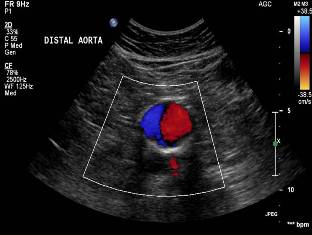Abdominal aortic aneurysm

Duplex ultrasound of a 5.5 centimeter abdominal aortic aneurysm
An aneurysm is a dilation of a segment of an artery. The aorta, the main artery through the trunk, can develop an aneurysm that can grow to the point of rupture of the aortic wall. The most common site for an aneurysm of the aorta is in the abdomen, below the level of the arteries to the kidneys (renal arteries). An abdominal aortic aneurysm (AAA) may not be detected on routine examinations, but ultrasound imaging provides an accurate, safe and non-invasive means to measure the aortic size.
When ballooning of the aorta leads to rupture, the results are catastrophic. Many people with a ruptured AAA don't make it to the hospital, and those who do often die of complications. Ruptured aortic aneurysm is the 13th leading cause of death in the U.S. — a cause of 15,000 deaths each year. Detection and treatment make this preventable.
The most important risk factors for abdominal aortic aneurysm development include: age over 60 years, a family history of AAA, cigarette smoking and high blood-pressure. When clinical assessment suggests an aneurysm may be present, an ultrasound evaluation in the Vascular Laboratory will be requested.
Some preparation is needed. The study examines arteries in the abdomen and pelvis. Gas in the intestinal tract can interfere with ultrasound evaluation. It is therefore best to have the examination performed after an overnight fast, and it is important to avoid tobacco and caffeine prior to the test. A complete examination may take as long as an hour.
The aorta in the abdomen is normally two centimeters or less in diameter. An aneurysm is present when the aorta is dilated to a diameter of three centimeters , but there is almost no risk of rupture until the aneurysm grows beyond this size. Evaluation of by a vascular surgeon is recommended if an AAA measures four centimeters in size or greater, though endovascular repair or surgery are usually not considered until the diameter of the aneurysm is at least 5.0 to 5.5 centimeters. When treatment is not yet needed, it is important to have follow-up evaluations every six to 12 months to assess for aneurysm growth.
